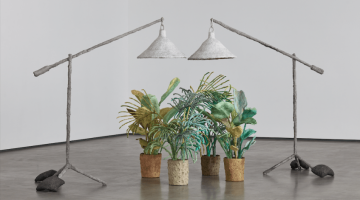It’s been nearly ten years since the car driven by Helmut Newton crashed in the driveway at the Chateau Marmont Hotel in Los Angeles, killing the photographer instantly. Before his premature passing, Newton left a body of work that effectively blurred the line between high fashion and fetish, commercial and fine art photography. Now on view at the Annenberg Space for Photography through September 8, the titular exhibition unites three series not previously exhibited together and reminds why he stood out among an elite group of artists who made their names at the height of 1970s and 80s fashion photography.
The title of the companion publication, its cover design specifically, says it all: “White Women,” “Sleepless Nights,” and “Big Nudes” – titles of Newton’s most well-known series that date to 1976, 1978, and 1981 respectively– are sandwiched between the photographer’s first and last like a middle name or an alias. Throughout the essays penned by fashion luminaries including Anna Wintour, editor-in-chief of American “Vogue”, and designer Karl Lagerfeld, Newton’s near obsession with women and how that desire was pursued photographically is reinforced. Anne Wilkes Tucker, the Houston Museum of Fine Arts esteemed photography curator, pens a basic introduction to Newton’s biography and work, but then smartly leaves the task of portraying the photographer’s aesthetic concerns and mode of production to those who knew him intimately.
Helmut Newton’s models graced the pages of magazines worldwide including “Jardin des modes”, “Claire”, “Elle”, and “Queen”, but nowhere more important than French “Vogue”, whose editors encouraged the photographer to take risks. Newton took those chances, envisioning each shoot as more than promotion for the latest in haute couture fashion. In fact, without captions identifying the designers, it is all but impossible to determine whose wares are showcased. Instead, Newton and June, his wife and long time collaborator, choreographed each session as an intimate, often erotically charged scene. “Saddle I”, for example, finds its edge from the perceived subjugation of a beautiful woman on the pages of a magazine with worldwide readership and, in retrospect, the foil of first wave feminism as it was in full swing in the mid-1970s.
Newton’s work calls to mind the photography of other luminaries, including Irving Penn, Richard Avedon and more recently Mario Testino and Patrick Demarchelier, all of whom portray fashion as high art. What sets Newton’s work apart from that of his talented contemporaries may be distilled to a tension between opposites – interior and exterior, self and other. Newton’s compositions encapsulate both physical interiors – often the picture of luxury and largesse – and the interior of the mind, where fantasy and reality vie for dominance. In this way, Newton’s work gestures to that of Hungarian photographer Brassaï, whose dramatic black and white compositions lead viewers through the sodium lit streets of Paris and into a secretive world of prostitutes and cross-dressing playboys.
Nude or fully dressed, Newton’s women exude strength, command attention, and offer themselves to be touched, if only through the all-consuming gaze. Throughout the time I spent in the exhibition, the photographs spurred my thoughts to Édouard Manet’s Olympia (1863), which scandalized visitors to the Paris Salon in 1865 and forcibly introduced polite society to modernist art. Helmut Newton’s models are, in a way, the inheritors of Olympia’s mantle, threading a fine line between availability and exclusivity, passivity and aggression. While the Annenberg Space for Photography does not rank among my favorite exhibition venues, the over-the-top glamor cut with intense psychological play that defines Helmut Newton’s work is perfectly situated in a city dedicated to surface appearances.
For more information visit here.
-Written by Roula Seikaly






